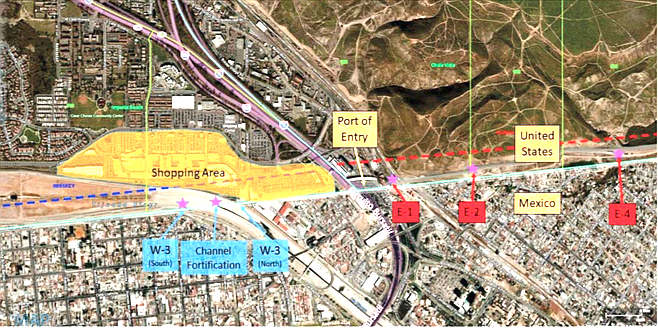 Facebook
Facebook
 X
X
 Instagram
Instagram
 TikTok
TikTok
 Youtube
Youtube

San Diego border Patrol agents improperly deployed high-powered "acoustic devices" during confrontations with migrants at the San Ysidro border two years ago, says a newly released audit by the federal Department of Homeland Security's Inspector General's office.
The same August 24 report, entitled "U.S. Customs and Border Protection Compliance with Use of Force Policy for Incidents on November 25, 2018, and January 1, 2019," clears the agency of misusing its tear gas arsenal.
"In response to congressional concerns, we reviewed [Customs and Border Protection's] use of tear gas against migrants near the San Ysidro, California Port of Entry on November 25, 2018," says the document.

"We also reviewed CBP's [Customs and Border Patrol] tear gas use in a January 1, 2019 incident near the same port of entry. Our objective was to examine circumstances surrounding the use of force in these incidents and determine whether CBP complied with its use of force policy."
The redacted document, formerly labeled Law Enforcement Sensitive, concludes that the two incidents of tear gas deployment against groups of migrants who rushed the border at San Ysidro complied with agency policy.
But auditors flagged as improper the use by untrained Border Patrol officers of an "acoustic device" deployed against the would-be border crossers, risking permanent damage to the migrants' hearing.
"Border Patrol obtained an acoustic device and used it in an 'alert tone' mode on November 25, 2018, which we determined did not conform to CBP's use of force policy because Border Patrol did not get advance authorization to have a device with this capability," the report says.
"Using the acoustic device in this mode may increase the risk of temporary or permanent hearing loss to those exposed to the sound and thereby increase the Government's risk of liability. "
The unidentified device was "borrowed" from the manufacturer on November 15 "for demonstration and testing in preparation for the migrant group's arrival," per the report.
"According to a San Diego Sector official, the device was to be used to gain attention and clearly communicate messages to a large group of people. The official also said the sector was unaware that use of the acoustic device in alert tone mode was not authorized."
Agency follow-up investigations also missed key details, says the audit.
"CBP's own internal investigation of the November 25, 2018 incident regarding the acoustic device was incomplete and inaccurate. Therefore, CBP did not have all the information it needed to determine whether the CBP officer and Border Patrol agents involved had complied with the use of force policy."
"We noted the following instances of inaccuracy and incompleteness, as well as inconsistencies between the [Border Patrol Office of Professional Responsibility’s] investigative report and Border Patrol agents' Incident statements.
"For example: The investigative report stated the acoustic device was used only in 'audio function' or 'audio mode' although agents did not include such information in their statements."
"The Use of Force Review Board's executive summary report indicated the the acoustic device was used for 'audio-only' as a public address system, although [the Office of Professional Responsibility] had radio transmission and video evidence that the device was used in alert tone mode.”
The report describes a chaotic scene confronted by agents patrolling the border. "In October 2018, CBP monitored an expanding group of about 7,000 migrants believed to be heading north from Honduras to the United States. According to CBP, as the group moved north, it overwhelmed Guatemalan and Mexican border security efforts with actions that included tearing down a border gate, throwing projectiles, and attempting to discharge weapons at border guards."
"On November 25, 2018, about 1,000 migrants attempted illegal entry into the United States near the San Ysidro, California Port of Entry in the San Diego Sector," according to the document. "On January 1, 2019, a group of about 100 migrants attempted to enter the United States illegally west of the San Ysidro, California [Port of Entry]."
"CBP personnel who used less-lethal devices in connection with both incidents generally reported they did so to protect themselves or other officers and agents from migrants throwing rocks and other projectiles."
The border patrol told auditors that its agents "intended to employ an acoustic device to broadcast spoken announcements to deter migrants from illegally crossing into the United States, per the report.
"However, the device was used in an 'alert tone,' reportedly to deter migrants from throwing rocks and projectiles."
According to the audit, "The alert tone produces a loud, piercing sound to gain attention or to cause physical discomfort in a target. The device can produce sound pressure levels that have the potential to cause temporary or permanent hearing damage."
On the other hand, auditors concluded, "Given the totality of circumstances" during the two incidents, the use of tear gas "appears to be within" the Border Patrol's policy.
"Border Patrol agents generally indicated that migrants began making verbal threats and throwing rocks at them while damaging fencing and the Tijuana River channel's dirt berm.
"Six Border Patrol agents reported individuals in Mexico were throwing rocks at CBP personnel while hiding behind members of the media."


San Diego border Patrol agents improperly deployed high-powered "acoustic devices" during confrontations with migrants at the San Ysidro border two years ago, says a newly released audit by the federal Department of Homeland Security's Inspector General's office.
The same August 24 report, entitled "U.S. Customs and Border Protection Compliance with Use of Force Policy for Incidents on November 25, 2018, and January 1, 2019," clears the agency of misusing its tear gas arsenal.
"In response to congressional concerns, we reviewed [Customs and Border Protection's] use of tear gas against migrants near the San Ysidro, California Port of Entry on November 25, 2018," says the document.

"We also reviewed CBP's [Customs and Border Patrol] tear gas use in a January 1, 2019 incident near the same port of entry. Our objective was to examine circumstances surrounding the use of force in these incidents and determine whether CBP complied with its use of force policy."
The redacted document, formerly labeled Law Enforcement Sensitive, concludes that the two incidents of tear gas deployment against groups of migrants who rushed the border at San Ysidro complied with agency policy.
But auditors flagged as improper the use by untrained Border Patrol officers of an "acoustic device" deployed against the would-be border crossers, risking permanent damage to the migrants' hearing.
"Border Patrol obtained an acoustic device and used it in an 'alert tone' mode on November 25, 2018, which we determined did not conform to CBP's use of force policy because Border Patrol did not get advance authorization to have a device with this capability," the report says.
"Using the acoustic device in this mode may increase the risk of temporary or permanent hearing loss to those exposed to the sound and thereby increase the Government's risk of liability. "
The unidentified device was "borrowed" from the manufacturer on November 15 "for demonstration and testing in preparation for the migrant group's arrival," per the report.
"According to a San Diego Sector official, the device was to be used to gain attention and clearly communicate messages to a large group of people. The official also said the sector was unaware that use of the acoustic device in alert tone mode was not authorized."
Agency follow-up investigations also missed key details, says the audit.
"CBP's own internal investigation of the November 25, 2018 incident regarding the acoustic device was incomplete and inaccurate. Therefore, CBP did not have all the information it needed to determine whether the CBP officer and Border Patrol agents involved had complied with the use of force policy."
"We noted the following instances of inaccuracy and incompleteness, as well as inconsistencies between the [Border Patrol Office of Professional Responsibility’s] investigative report and Border Patrol agents' Incident statements.
"For example: The investigative report stated the acoustic device was used only in 'audio function' or 'audio mode' although agents did not include such information in their statements."
"The Use of Force Review Board's executive summary report indicated the the acoustic device was used for 'audio-only' as a public address system, although [the Office of Professional Responsibility] had radio transmission and video evidence that the device was used in alert tone mode.”
The report describes a chaotic scene confronted by agents patrolling the border. "In October 2018, CBP monitored an expanding group of about 7,000 migrants believed to be heading north from Honduras to the United States. According to CBP, as the group moved north, it overwhelmed Guatemalan and Mexican border security efforts with actions that included tearing down a border gate, throwing projectiles, and attempting to discharge weapons at border guards."
"On November 25, 2018, about 1,000 migrants attempted illegal entry into the United States near the San Ysidro, California Port of Entry in the San Diego Sector," according to the document. "On January 1, 2019, a group of about 100 migrants attempted to enter the United States illegally west of the San Ysidro, California [Port of Entry]."
"CBP personnel who used less-lethal devices in connection with both incidents generally reported they did so to protect themselves or other officers and agents from migrants throwing rocks and other projectiles."
The border patrol told auditors that its agents "intended to employ an acoustic device to broadcast spoken announcements to deter migrants from illegally crossing into the United States, per the report.
"However, the device was used in an 'alert tone,' reportedly to deter migrants from throwing rocks and projectiles."
According to the audit, "The alert tone produces a loud, piercing sound to gain attention or to cause physical discomfort in a target. The device can produce sound pressure levels that have the potential to cause temporary or permanent hearing damage."
On the other hand, auditors concluded, "Given the totality of circumstances" during the two incidents, the use of tear gas "appears to be within" the Border Patrol's policy.
"Border Patrol agents generally indicated that migrants began making verbal threats and throwing rocks at them while damaging fencing and the Tijuana River channel's dirt berm.
"Six Border Patrol agents reported individuals in Mexico were throwing rocks at CBP personnel while hiding behind members of the media."
Comments